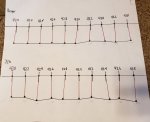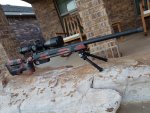Maybe we are just talking past one another without understanding. I genuinely want to understand what you are saying and seeing. If you would, explain again please how you are defining the randomness you are seeing vs the lining up of the other charges.
Are you looking at group size, or shape or orientation to the point of aim? Here is the OP's target:
I see the pattern in the distance below the point of aim, and I see definite groupings in the angle from the point of aim. There are definite and recognizable patterns there. I can't see any discernible pattern in the size or shape of any of the groups.
What am I not seeing?


